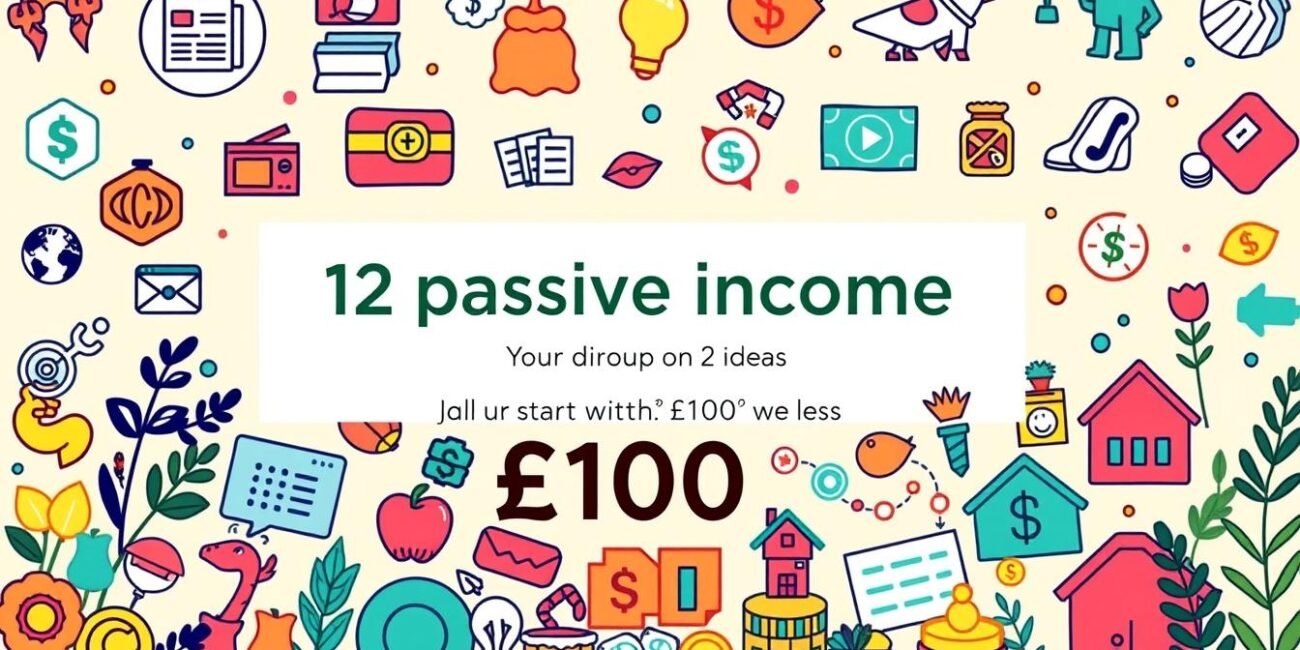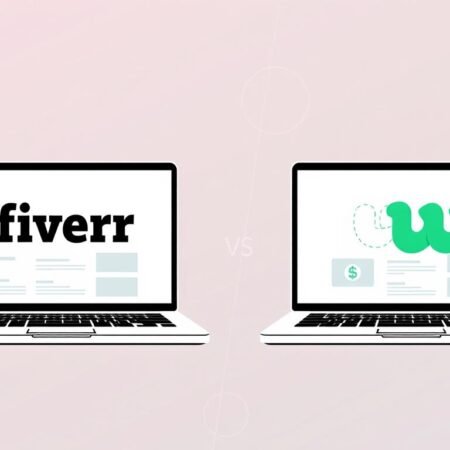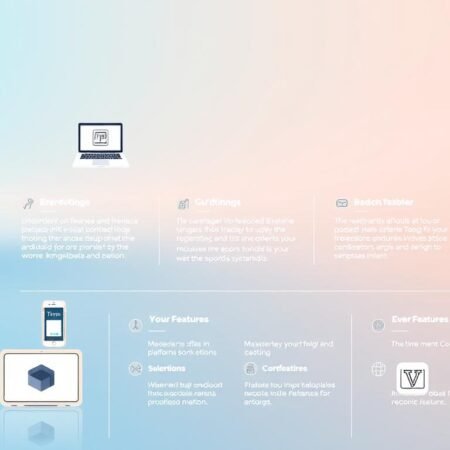Have you ever wondered if it’s possible to generate earnings without constant effort? Many people dream of financial freedom but often misunderstand what it truly takes to achieve it. This article explores how you can start building a steady stream of earnings with just £100 or less.
Contrary to popular belief, not all opportunities are entirely hands-off. Some require initial effort, but the rewards can be significant. In the UK, factors like tax implications and market accessibility play a crucial role in determining the best strategies for you.
We’ve curated 12 low-cost methods that are scalable and beginner-friendly. Whether you’re looking to diversify your earnings or start something new, these ideas can help you take the first step. So, are you ready to discover how £100 can transform your financial future?
Introduction to Passive Income Ideas
Building a steady cash flow with minimal effort is a goal many aspire to. Unlike active income, which requires continuous work, passive revenue streams allow you to earn with less ongoing involvement. Understanding this distinction is crucial for anyone looking to diversify their earnings.
According to the IRS, passive income typically comes from rental properties, businesses where you’re not actively involved, or investments. In the UK, tax considerations play a significant role, so it’s essential to understand how these earnings are treated. Always consult a tax advisor to ensure compliance.

One of the key principles of generating passive income is balancing upfront effort with long-term returns. While some opportunities require initial work, the rewards can be substantial over time. Risk management is equally important; not all ventures guarantee success, so diversification is advisable.
In the UK, several platforms cater to those looking to start with minimal investment. From crowdfunding to peer-to-peer lending, these options often have low thresholds, making them accessible even with £100 or less. This framework allows you to evaluate opportunities without significant financial risk.
By focusing on scalable and beginner-friendly methods, you can take the first step towards financial freedom. Whether it’s through investments or creative ventures, the potential to generate passive income is within reach.
1. Invest in High-Quality Dividend Stocks
Ever considered how small investments can lead to steady returns? Dividend stocks are shares in companies that pay out a portion of their profits to shareholders. These payouts, known as dividends, can provide a reliable income stream over time.

What Are Dividend Stocks?
Dividend stocks are ideal for those seeking consistent earnings. Companies with a history of paying dividends, often referred to as dividend aristocrats, have maintained payouts for 25+ years. These firms are typically stable and financially sound, making them a lower-risk investment option.
Dividends are usually paid quarterly or annually, depending on the company. Some platforms even offer Dividend Reinvestment Plans (DRIPs), which automatically reinvest your dividends to buy more shares, accelerating compound growth.
How to Get Started with £100
Starting with £100 is easier than you might think. Platforms like Trading 212 and eToro allow you to buy fractional shares, meaning you can invest in high-quality stocks without needing to purchase a full share. This makes it accessible for beginners.
For example, if you invest £100 in a stock with a 4% dividend yield, you could earn £4 annually. While this may seem small, reinvesting these earnings can lead to significant growth over time.
However, it’s essential to consider risks. Company stability and sector trends can impact dividend payouts. Diversifying your investments across multiple sectors can help mitigate these risks.
2. Real Estate Rentals: Managed or Crowdfunded
Real estate investments don’t always require massive upfront costs. With platforms like Fundrise and RealtyMogul, you can start with as little as £100. These companies allow you to pool funds with other investors, making property investments accessible to everyone.

Benefits of Real Estate Crowdfunding
Crowdfunding offers several advantages. First, it allows you to diversify your portfolio without buying an entire property. Second, you can earn both rental income and benefit from property appreciation. Third, platforms handle property management, saving you time and effort.
In the UK, regulations ensure transparency and security for investors. Tax-efficient ISAs are also available, making it a smart choice for long-term growth. However, it’s essential to understand exit strategies and liquidity considerations before investing.
How to Start with Minimal Investment
Starting with £100 is straightforward. Choose a reputable platform, such as Fundrise or RealtyMogul, and create an account. These platforms offer fractional investments, meaning you can own a share of a property without buying it outright.
For example, if you invest £100 in a property with an 8% annual return, you could earn £8 yearly. While this may seem small, reinvesting earnings can lead to significant growth over time. Always research the market and diversify your investments to mitigate risks.
| Aspect | REITs | Crowdfunding Platforms |
|---|---|---|
| Minimum Investment | £500+ | £100 |
| Management | Managed by professionals | Handled by platform |
| Liquidity | High (traded on stock exchanges) | Low (long-term commitment) |
| Returns | Dividends + capital gains | Rental income + property appreciation |
By understanding these options, you can make informed decisions and start building your real estate portfolio with minimal risk. Whether you choose REITs or crowdfunding, the potential for steady income is within reach.
3. Write a Book or Create Educational Content
Sharing your knowledge can be both fulfilling and financially rewarding. Whether you’re an expert in a niche field or have a passion for teaching, creating educational content offers a scalable way to generate revenue. With minimal upfront costs, this approach is accessible to almost anyone.

Choosing the Right Topic
Selecting an evergreen topic is crucial for long-term success. Evergreen topics are those with lasting demand, such as personal finance, health, or career development. These subjects remain relevant regardless of trends, ensuring your work continues to attract readers or students.
Consider your expertise and audience needs. For example, if you’re skilled in graphic design, creating a course on Canva Pro could be a great fit. A case study showed that a £70 investment in Canva Pro for course design yielded significant returns. Always aim to address a specific problem or gap in the market.
Platforms to Publish Your Work
Once your content is ready, choosing the right platform is essential. Amazon KDP is ideal for e-books, while Udemy and Teachable cater to online courses. Each platform has its own royalty structure, so it’s worth comparing them to maximise your earnings.
For instance, Amazon KDP offers up to 70% royalties for e-books, while Udemy provides a sliding scale based on course sales. Teachable allows you to keep 100% of your revenue if you use their free plan, making it a cost-effective option for beginners.
| Platform | Content Type | Royalty Structure |
|---|---|---|
| Amazon KDP | E-books, Audiobooks | Up to 70% |
| Udemy | Online Courses | Sliding scale (up to 50%) |
| Teachable | Online Courses | 100% (on free plan) |
Repurposing your content across platforms like Medium or Substack can further amplify your reach. For example, an e-book can be adapted into blog posts or a newsletter series. This strategy not only saves time but also ensures your work reaches a wider audience.
By leveraging your expertise and the right platforms, you can turn your knowledge into a sustainable source of revenue. Whether it’s through writing, teaching, or both, the opportunities are endless.
4. License Your Work and Intellectual Property
Licensing your creative output can unlock new revenue streams with minimal ongoing effort. Whether you’re a musician, designer, or developer, licensing allows you to monetise your skills while retaining ownership of your work. This approach is particularly effective in the UK, where copyright laws protect creators and ensure fair compensation.

Types of Work You Can License
Almost any creative work can be licensed. Music, for example, can be licensed for use in podcasts, films, or advertisements. Epidemic Sound is a popular platform for music licensing, offering royalties to creators. Similarly, WordPress themes, graphic designs, and even photography can be licensed for personal or commercial use.
Niche opportunities, such as podcast jingles or stock footage, are also in demand. Companies like Envato Market allow you to sell digital assets, paying royalties of 50-70%. By focusing on evergreen niches, you can ensure your work remains relevant and profitable.
How to Market Your Licensed Work
Promoting your work effectively is key to success. Portfolio sites like Behance and Dribbble are excellent for showcasing your creations. These platforms attract businesses and individuals looking for high-quality media assets. Additionally, leveraging social media can amplify your reach and attract potential buyers.
Pricing strategies vary depending on the type of work and its intended use. Tiered licensing, which distinguishes between personal and commercial use, is a common approach. For example, a WordPress theme might cost £20 for personal use but £100 for commercial projects. This flexibility ensures your work appeals to a broader audience.
| Platform | Type of Work | Royalty Rate |
|---|---|---|
| Envato Market | Digital Assets | 50-70% |
| Epidemic Sound | Music Licensing | Varies |
| Behance | Portfolio Showcase | N/A |
By understanding copyright laws and leveraging the right platforms, you can turn your creative work into a sustainable source of revenue. Licensing offers a scalable and low-effort way to monetise your skills, making it an ideal choice for UK creators.
5. Create a Niche Subscription Newsletter
Looking for a way to share your expertise while earning? A niche subscription newsletter could be your answer. This model allows you to monetise your knowledge by delivering valuable content directly to your audience. With minimal upfront costs, it’s an accessible option for many creators in the UK.

Identifying Your Niche
Choosing the right niche is crucial for success. Analyse trending topics in the UK, such as sustainable living or side hustles. These areas have growing audiences and offer opportunities for unique insights. Focus on a subject you’re passionate about and ensure there’s a demand in the market.
Lead magnets, like free guides or exclusive tips, can help convert readers into subscribers. For example, a free eBook on eco-friendly living could attract those interested in sustainability. Tailor your content to address specific pain points or interests.
Platforms to Host Your Newsletter
Selecting the right platform is key. Substack is popular but takes a 10% fee, while Ghost offers a lower 5% commission. Both platforms provide tools to manage subscriptions and deliver content seamlessly.
Compare email marketing tools like ConvertKit and MailerLite to find the best fit for your needs. These tools offer features like automation and analytics, helping you grow your subscriber base effectively.
Monetisation tactics include sponsored sections and affiliate links. For instance, partnering with eco-friendly brands can generate additional revenue. With 500 subscribers paying £5/month, you could earn £2,500 annually. Leverage social media to promote your newsletter and reach a wider audience.
6. Affiliate Marketing Through a Website or Niche Blog
Affiliate marketing offers a flexible way to earn while sharing products you love. By promoting products or services on your website or blog, you can generate income through commissions. This approach is particularly effective in the UK, where platforms like Amazon Associates and Awin provide accessible opportunities for beginners.
Choosing the Right Affiliate Programs
Selecting the right affiliate programmes is crucial for success. Amazon Associates UK, for example, offers commissions ranging from 1% to 10%, depending on the product category. Awin, on the other hand, specialises in brand partnerships, providing a wide range of options for niche bloggers.
Cookie durations vary across programmes, typically lasting between 30 and 180 days. This means you’ll earn a commission if a purchase is made within this timeframe after clicking your link. Always check the terms and conditions to ensure the programme aligns with your goals.
Building Trust with Your Audience
Transparency is key in affiliate marketing. The UK’s FTC requires bloggers to disclose affiliate links clearly. This builds trust with your audience and ensures compliance with regulations. Honest reviews and genuine recommendations can strengthen your credibility.
Content strategies like product comparisons and tutorials are effective ways to engage readers. For instance, a detailed guide on the best budget laptops can attract tech enthusiasts while promoting affiliate links naturally.
| Platform | Commission Range | Cookie Duration |
|---|---|---|
| Amazon Associates UK | 1-10% | 24 hours |
| Awin | Varies | 30-180 days |
SEO tactics, such as keyword optimisation and backlinking, can help your content rank higher on search engines. Tools like Pretty Links and Google Analytics are invaluable for tracking clicks and conversions. By combining these strategies, you can maximise your income and grow your affiliate marketing work effectively.
7. Sell Stock Photography or Footage
Have you ever thought about turning your photos into a steady stream of cash? Selling stock photography or footage is a fantastic way to monetise your creative skills. With platforms like Shutterstock and Adobe Stock, you can earn royalties for every download, making it a scalable option for UK creators.
Best Platforms for Selling Stock Media
Choosing the right platform is crucial for maximising your earnings. Shutterstock, for example, pays between £0.25 and £4.50 per download, depending on the licensing type. Adobe Stock is another excellent choice, especially for beginners, as it accepts smartphone shots, making it accessible to everyone.
Other platforms like Alamy and iStock also offer competitive rates. Each platform has its own submission guidelines and royalty structures, so it’s worth comparing them to find the best fit for your work.
Tips for Creating Marketable Content
To succeed in the competitive world of stock photography, focus on UK-specific demands. Cultural events, landmarks, and seasonal themes are always in high demand. For instance, images of London’s skyline or Edinburgh’s festivals can attract buyers year-round.
Equipment doesn’t have to be a barrier. Modern smartphones can produce high-quality images, especially when paired with good lighting and composition. However, investing in a DSLR can enhance your portfolio and open up more opportunities.
Metadata tagging is essential for discoverability. Use relevant keywords like “UK landmarks” or “autumn festivals” to ensure your work appears in search results. Seasonal content calendars can also help you plan shoots to align with peak demand periods.
| Platform | Royalty per Download | Acceptance Criteria |
|---|---|---|
| Shutterstock | £0.25 – £4.50 | High-resolution images |
| Adobe Stock | £0.25 – £3.00 | Smartphone shots accepted |
| Alamy | 50% commission | Unique, high-quality content |
Export settings are another critical factor. Ensure your images are in high resolution (at least 300 DPI) and saved in formats like JPEG or PNG. For footage, MP4 is the standard. Always include model or property releases if applicable to avoid legal issues.
By focusing on these strategies, you can turn your passion for photography into a reliable source of income. Whether you’re a seasoned photographer or just starting, the opportunities in media are vast and rewarding.
8. Equipment Rental
Do you have items gathering dust that could be earning you money? Renting out unused equipment is a practical way to generate extra cash while making the most of your inventory. Whether it’s a DSLR camera or camping gear, many items can be turned into a profitable rental business.
What Equipment Can You Rent Out?
Start by identifying underutilised assets. Common items include projectors, camping gear, and photography equipment. For example, DSLR cameras can earn an average of £50 per day on platforms like Fat Llama, which charges a 15-25% fee. Other options include power tools, event equipment, or even musical instruments.
How to Manage Your Rental Business
Running a successful rental business requires careful planning. First, ensure you have proper insurance to cover potential damages. In the UK, specific policies are available for rental businesses, so consult an expert to find the right coverage.
Next, choose the right platform. Peer-to-peer platforms like Fat Llama offer wide reach, while local Facebook groups can help you connect with nearby customers. Compare fees and audience size to decide what works best for you.
Maintenance is crucial for equipment longevity. Create a schedule to inspect and clean items regularly. This not only extends their lifespan but also ensures customer satisfaction.
Finally, protect yourself with clear contracts. Use templates that outline terms, including damage protection and late return fees. This minimises risks and keeps your business running smoothly.
By leveraging your unused items, you can create a steady stream of cash while offering valuable services to others. Start small, and scale as you gain experience and confidence.
9. Peer-to-Peer Lending
Have you considered lending your money directly to businesses or individuals? Peer-to-peer (P2P) lending is a growing trend in the UK, offering an alternative to traditional savings accounts. With platforms like Funding Circle and Zopa, you can earn returns of 6-12% annually, making it an attractive option for those looking to grow their cash.
Understanding Peer-to-Peer Lending Risks
While P2P lending can be profitable, it’s essential to understand the risks. The Financial Conduct Authority (FCA) regulates UK platforms to ensure transparency and security. However, borrowers may default on loans, impacting your returns. Diversifying your investments across multiple loans can help mitigate this risk.
Secured loans, backed by assets, are generally safer than unsecured ones. Platforms often provide risk ratings for each loan, helping you make informed decisions. Auto-invest tools can also simplify the process by spreading your funds across various opportunities automatically.
How to Start with £100
Starting with £100 is straightforward. Platforms like Zopa and Funding Circle allow you to invest small amounts. Zopa’s Innovative Finance ISA (IFISA) wrapper offers tax-free returns, making it a smart choice for UK investors. This means you can earn income without worrying about tax implications.
Research the market and choose reputable companies with strong track records. Compare fees, loan types, and borrower profiles to find the best fit for your goals. With careful planning, P2P lending can become a reliable part of your investment strategy.
10. Start a Blog
Ever thought about turning your passion into a profitable online space? Blogging is a versatile way to share your expertise, connect with others, and even generate revenue. With platforms like WordPress.org costing as little as £30-£100 annually, it’s an accessible option for anyone in the UK.
Choosing a Blogging Niche
Selecting the right niche is crucial for success. Use tools like AnswerThePublic to analyse UK search trends and identify topics with high demand. Evergreen subjects, such as personal finance or health, often perform well. Focus on areas you’re passionate about to ensure consistency in your work.
When choosing a domain, consider .co.uk for a local audience or .com for global reach. A memorable domain name can enhance your blog’s visibility and credibility. Pair this with a clear content strategy to attract and retain readers.
Monetising Your Blog
Once your blog gains traction, there are several ways to monetise it. Display ads, for example, can earn £10-£50 per 1,000 visitors. Networks like Mediavine require at least 50,000 monthly sessions, so focus on growing your audience first.
Affiliate marketing is another effective option. Platforms like Affiliate Window UK offer partnerships with brands, allowing you to earn commissions on sales. Repurposing content for Pinterest or YouTube can also drive traffic and increase earnings.
| Monetisation Method | Earnings Potential | Requirements |
|---|---|---|
| Display Ads | £10-£50/1k visitors | 50k+ monthly sessions |
| Affiliate Marketing | Varies | Partnership with brands |
By combining these strategies, you can turn your blog into a sustainable business. Whether you’re sharing ideas or promoting products, the opportunities are endless.
11. Publish a Digital Product
Digital products offer a scalable way to earn from your creativity. Whether you’re a designer, writer, or developer, creating downloadable assets can unlock new revenue streams with minimal ongoing effort. In the UK, this approach is particularly appealing due to its low upfront costs and high earning potential.
Types of Digital Products You Can Create
From Notion templates to Excel macros, the possibilities are endless. Evergreen formats like eBooks, online courses, and design assets are always in demand. For instance, a well-designed Notion template can sell for £20-£50, depending on its complexity and utility.
Other trending options include stock photography, music tracks, and digital planners. These products cater to niche audiences, ensuring steady sales over time. Focus on your expertise and identify gaps in the market to create something unique.
Platforms to Sell Your Digital Products
Choosing the right platform is crucial for success. Gumroad, for example, charges a 10% fee but offers a user-friendly interface. Sellfy provides a 14-day free trial, making it ideal for beginners. Both platforms handle VAT requirements for EU sales, simplifying the process for UK creators.
Hosted storefronts like Gumroad and Sellfy are great for beginners, while self-hosted options like WooCommerce offer more control. Compare features, fees, and audience reach to find the best fit for your needs.
| Platform | Fee | VAT Handling | Best For |
|---|---|---|---|
| Gumroad | 10% | Yes | Beginners |
| Sellfy | 14-day free trial | Yes | Small-scale creators |
| WooCommerce | Self-hosted | Manual | Advanced users |
Packaging strategies can also boost sales. Bundling related products, like a Notion template and an eBook, often attracts more buyers. Ensure your delivery systems are GDPR-compliant to protect customer data and build trust.
By leveraging your skills and the right platforms, you can turn your creativity into a sustainable source of revenue. Start small, experiment with formats, and scale as you gain confidence.
12. Create an Online Course
Creating an online course could be your next big step. With the rise of digital learning, sharing your knowledge has never been easier. Whether you’re an expert in coding, cooking, or crafting, an online course offers a flexible way to reach a global audience.
Identifying Your Expertise
Start by choosing a niche that aligns with your skills and market demand. Tools like Google Keyword Planner can help you identify trending topics in the UK. For example, courses on digital marketing or personal finance are highly sought after.
Evergreen topics, such as health or career development, ensure your course remains relevant. Focus on solving specific problems or addressing gaps in the market. This approach not only attracts learners but also positions you as an authority in your field.
Platforms to Host Your Course
Selecting the right platform is crucial. Udemy, for instance, charges a 75% commission but offers a vast audience. Thinkific, on the other hand, provides a free tier, making it ideal for beginners.
Video hosting is another consideration. Platforms like Vimeo and Wistia offer different pricing plans, so compare features to find the best fit. For corporate training, ensure your course is SCORM-compliant to meet industry standards.
Upsell strategies, such as offering coaching add-ons or certificates, can boost your earnings. Equipment recommendations under £100, like a good microphone or ring light, can also enhance your course quality without breaking the bank.
By leveraging your expertise and the right tools, you can create a course that not only shares your knowledge but also generates a steady stream of revenue. Start small, and scale as you gain confidence and experience.
Conclusion
Starting small doesn’t mean limiting your financial potential. The strategies outlined in this article show how you can begin with under £100 and gradually build a diverse income stream. While some methods require upfront effort, the long-term rewards can be significant.
Consistency is key. Whether you’re investing in dividend stocks, creating digital products, or exploring affiliate marketing, dedicating time initially can lead to compounding benefits over 1-5 years. Tracking your progress with tools like spreadsheets or apps can help you stay organised and monitor your growth.
For UK residents, understanding tax implications is crucial. Resources like HMRC’s self-assessment guides can simplify this process. By taking these steps, you can turn small investments into a steady flow of money and achieve your financial goals.











